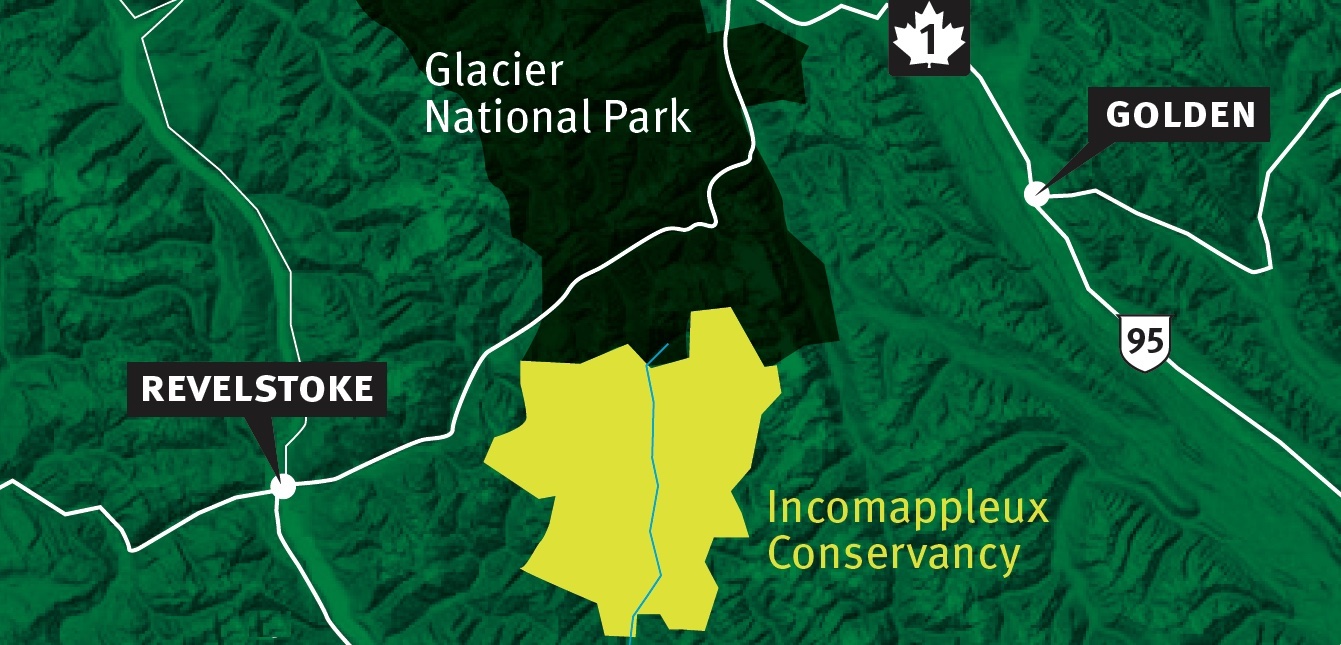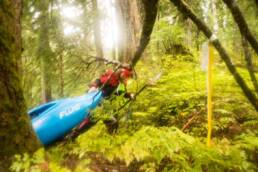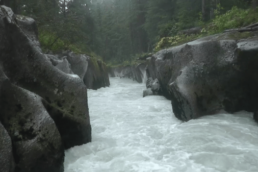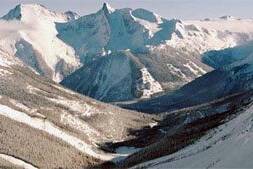British Columbia’s newest nature conservancy is a marvel of 2,000-year-old trees and wildlife. Just don’t expect guided tours anytime soon.
Story by Jayme Moye. Feature photo by Steve Ogle of Rossland, BC, resident Sven Perschmann on his way to making the first descent of the Incomappleux River, in 2013, with seven other paddlers. This section of old-growth forest was flagged and would have been logged if the conservancy had not been created.
Biologists have dubbed the Incomappleux River Valley, located northeast of Nakusp, British Columbia, as primeval because it has probably been growing uninterrupted since the last ice age. And this year, the British Columbia government ensured some areas within it will continue to thrive without the threat of logging or development. On January 25, 2023, the province created a new nature conservancy encompassing 58,000 hectares of remote wilderness in the valley and 17,000 hectares at the southern end where forestry will be prohibited. “It’s phenomenal old-growth forest—trees up to four metres in diameter, upward of 2,000 years old,” says Craig Pettitt, a director of the Valhalla Wilderness Society and one of the strongest voices calling for the protection of the Incomappleux for two decades.
Among the ancient cedar and hemlock trees, scientists have identified more than 250 species of lichen, including seven species never seen before. The Incomappleux is also home to bears, moose, elk, white-tailed deer, mule deer, wolverines, and wolves. In 2017, Pettitt found a grizzly track measuring a whopping 40 centimetres from claw to heel, the average length of a human femur.

The name Incomappleux is derived from the Sinixt word nk’mapeleqs, which means “point at end,” referring to the northeastern tip of Upper Arrow Lake, where the river empties. Scientists call it an inland temperate rainforest, a rare ecosystem that doesn’t exist anywhere else on the planet except for small remnants in Siberia and eastern Russia. Like its cousin on the coast, this inland rainforest is wet all year, but most of the moisture comes from snow rather than rain. It’s also rich with biodiversity and absorbs substantial amounts of carbon dioxide from the atmosphere, reducing the effects of climate change.
Few people have had the opportunity to explore the Incomappleux because it is notoriously difficult to navigate. Nor are there any plans to improve access, which bodes well for wildlife that need room to roam, such as grizzlies. Pettit says the next task for the Valhalla Wilderness Society is to secure further protections for the Westfall Valley, an area adjacent to the Incomappleux that is also part of the inland temperate rainforest and contains critical mountain caribou habitat. He would show it to you, but it’s even more difficult to access.
Jayme Moye
Jayme Moye is an award-winning writer who specializes in stories about travel, mountain sports and culture, and pushing the limits of human potential. Her freelance work regularly appears in Outside, Canadian Geographic, National Geographic, and Condé Nast Traveler, among others. She is a Senior Writer with Kootenay Mountain Culture Magazine.
Related Stories
First Descent of the Incomappleux
Kootenay kayaker Carl Jacks and his merry band of uber gnarly whitewater addicts dive deep into one of the last un-run…
STAND movie hits BC in early May
From our Friends Anthony Bonello of b4apres Media, and Nicolas Teichrob, photographer comes the cinematic premier of…
Creaking Tree String Quartet touring BC
Two time Juno nominees, The Creaking Tree String Quartet are coming to British Columbia to promote there fourth Album.…
Cool New Video by Nelson BC’s Best Western Hotel
The world of the webisode gets funner by the day. This new piece by the local Nelson family that runs the town's Best…
New BC Bike Race Movie Lands Today
BC Bike Race has released its third feature film, "The Journey," documenting the 2017 event. Watch it below. Director,…








